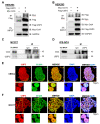Ubiquitin-Specific Protease 3 Deubiquitinates and Stabilizes Oct4 Protein in Human Embryonic Stem Cells
- PMID: 34070420
- PMCID: PMC8197518
- DOI: 10.3390/ijms22115584
Ubiquitin-Specific Protease 3 Deubiquitinates and Stabilizes Oct4 Protein in Human Embryonic Stem Cells
Abstract
Oct4 is an important mammalian POU family transcription factor expressed by early human embryonic stem cells (hESCs). The precise level of Oct4 governs the pluripotency and fate determination of hESCs. Several post-translational modifications (PTMs) of Oct4 including phosphorylation, ubiquitination, and SUMOylation have been reported to regulate its critical functions in hESCs. Ubiquitination and deubiquitination of Oct4 should be well balanced to maintain the pluripotency of hESCs. The protein turnover of Oct4 is regulated by several E3 ligases through ubiquitin-mediated degradation. However, reversal of ubiquitination by deubiquitinating enzymes (DUBs) has not been reported for Oct4. In this study, we generated a ubiquitin-specific protease 3 (USP3) gene knockout using the CRISPR/Cas9 system and demonstrated that USP3 acts as a protein stabilizer of Oct4 by deubiquitinating Oct4. USP3 interacts with endogenous Oct4 and co-localizes in the nucleus of hESCs. The depletion of USP3 leads to a decrease in Oct4 protein level and loss of pluripotent morphology in hESCs. Thus, our results show that USP3 plays an important role in controlling optimum protein level of Oct4 to retain pluripotency of hESCs.
Keywords: 26S proteasome; CRISPR/Cas9; embryonic carcinoma cells; gene knockout; post-translational modifications.
Conflict of interest statement
The authors declare no competing interests. The funders had no role in the design of the study; in the collection, analyses, or interpretation of data; in the writing of the manuscript, or in the decision to publish the results.
Figures





Similar articles
-
CRISPR/Cas9-based genome-wide screening of the deubiquitinase subfamily identifies USP3 as a protein stabilizer of REST blocking neuronal differentiation and promotes neuroblastoma tumorigenesis.J Exp Clin Cancer Res. 2023 May 12;42(1):121. doi: 10.1186/s13046-023-02694-1. J Exp Clin Cancer Res. 2023. PMID: 37170124 Free PMC article.
-
Oct4 maintains the pluripotency of human embryonic stem cells by inactivating p53 through Sirt1-mediated deacetylation.Stem Cells. 2014 Jan;32(1):157-65. doi: 10.1002/stem.1532. Stem Cells. 2014. PMID: 24038750 Free PMC article.
-
Regulation of pluripotency and differentiation by deubiquitinating enzymes.Cell Death Differ. 2016 Aug;23(8):1257-64. doi: 10.1038/cdd.2016.53. Epub 2016 Jun 10. Cell Death Differ. 2016. PMID: 27285106 Free PMC article. Review.
-
Leucine-Rich Repeat Neuronal Protein 1 Regulates Differentiation of Embryonic Stem Cells by Post-Translational Modifications of Pluripotency Factors.Stem Cells. 2018 Oct;36(10):1514-1524. doi: 10.1002/stem.2862. Epub 2018 Jul 29. Stem Cells. 2018. PMID: 29893054
-
Regulation of the protein stability and transcriptional activity of OCT4 in stem cells.Adv Biol Regul. 2021 Jan;79:100777. doi: 10.1016/j.jbior.2020.100777. Epub 2020 Dec 29. Adv Biol Regul. 2021. PMID: 33451972 Review.
Cited by
-
USP3 inhibition is Active Against Chemo-resistant Hepatocellular Carcinoma Anchorage-independent Growth via Suppressing Wnt/β-catenin.Curr Mol Med. 2024;24(5):667-675. doi: 10.2174/0115665240258296231024112309. Curr Mol Med. 2024. PMID: 37921189
-
OLMALINC/OCT4/BMP2 axis enhances osteogenic-like phenotype of renal interstitial fibroblasts to participate in Randall's plaque formation.Mol Med. 2022 Dec 29;28(1):162. doi: 10.1186/s10020-022-00576-4. Mol Med. 2022. PMID: 36581839 Free PMC article.
-
USP7 represses lineage differentiation genes in mouse embryonic stem cells by both catalytic and noncatalytic activities.Sci Adv. 2023 May 19;9(20):eade3888. doi: 10.1126/sciadv.ade3888. Epub 2023 May 17. Sci Adv. 2023. PMID: 37196079 Free PMC article.
-
USP3: Key deubiquitylation enzyme in human diseases.Cancer Sci. 2024 Jul;115(7):2094-2106. doi: 10.1111/cas.16178. Epub 2024 Apr 23. Cancer Sci. 2024. PMID: 38651282 Free PMC article. Review.
-
The Suppression of Ubiquitin C-Terminal Hydrolase L1 Promotes the Transdifferentiation of Auditory Supporting Cells into Hair Cells by Regulating the mTOR Pathway.Cells. 2024 Apr 24;13(9):737. doi: 10.3390/cells13090737. Cells. 2024. PMID: 38727276 Free PMC article.
References
-
- Buckley S.M., Aranda-Orgilles B., Strikoudis A., Apostolou E., Loizou E., Moran-Crusio K., Farnsworth C.L., Koller A.A., Dasgupta R., Silva J.C., et al. Regulation of pluripotency and cellular reprogramming by the ubiquitin-proteasome system. Cell Stem Cell. 2012;11:783–798. doi: 10.1016/j.stem.2012.09.011. - DOI - PMC - PubMed
MeSH terms
Substances
Grants and funding
LinkOut - more resources
Full Text Sources
Research Materials
Miscellaneous

